9. 爬虫入门#
Python 的爬虫功能使得程序员可以快速抓取并分析网页中的信息,它实质上是模拟浏览器访问网页。本章主要常用的两个爬虫相关的库requests,beautifulsoup4。若要模拟鼠标点击等,要用到selenium 库,限于篇幅限制,本章不再介绍,具体可以查阅相关资料。
9.1. requests 库#
每个网页都有源代码,可以通过鼠标单击右键查看网页源代码。网页中的很多信息都在源代码里面,requests 是一个访问网页源代码的库。一般通过 get 函数访问网页,另外一个常用来访问网页的函数是 post,与 get 函数的区别在于 post 能够传递表格或文件到网页所在服务器上。
| get(url, [timeout], [headers], [proxies], **kwargs) | |
|---|---|
| url | 网页链接 |
| timeout | 可选参数,请求网页的最大时长,单位为秒 |
| headers | 可选参数,模拟浏览器设置 |
| proxies | 可选参数,代理服务器设置 |
| **kwargs | 其他参数 |
get 或 post 函数返回一个 Resoponse 对象,该对象包括以下常用的属性或函数。
属性或函数 |
描述 |
|---|---|
status_code |
网页请求的返回状态,200 表示连接成功,404 表示连接失败 |
text |
响应网页的字符串内容 |
encoding |
响应网页的编码方式,可以更改 |
content |
相应网页的字节形式内容,例如图片或 pdf 文件等 |
raise_for_status() |
如果网页访问不成功,抛出异常,一般结合 try-except 语句使用 |
json() |
该函数可以解析网页内容中 JSON 格式的数据 |
import requests
r = requests.get("http://www.baidu.com")
r.status_code
200
r.text # 结果省略
r.encoding # 若为 ISO-8859-1 则中文为乱码
'ISO-8859-1'
r.encoding = "utf-8" # 无论网页原内容是什么编码,都改成 utf-8 编码
9.2. beautifulsoup4库#
使用requests获取的网页源代码一般非常复杂,不仅包括常规内容,还包括很多定义页面格式的代码。
tips
网页中的内容一般在网页源代码的各个标签里
例如有下面的 html 代码:
html_doc = """
<html>
<body>
<h1>Hello, BeautifulSoup!</h1>
<ul>
<li><a class = "c1" href="http://example1.com">Link 1</a></li>
<li><a class = "c2" href="http://example2.org">Link 2</a></li>
</ul>
<div>
<p>text1</p> <p>text2</p>
</div>
</body>
</html>
"""
beautifulsoup4库提供了大量的属性或函数,能够方便地将网页(html)不同标签(tag)中的内容提取出来。常用的属性有下面几个:
属性 |
描述 |
|---|---|
head |
网页源代码中的 <head> 标签内容 |
title |
网页源代码中的 <title> 标签内容 |
body |
网页源代码中的 <body> 标签内容 |
p |
网页源代码中的第一个 <p> 标签内容 |
a |
网页源代码中的第一个 <a> 标签内容 |
div |
网页源代码中的第一个 <div> 标签内容 |
script |
网页源代码中的第一个 <script> 标签内容 |
from bs4 import BeautifulSoup
r = requests.get("http://www.baidu.com")
r.encoding = "utf-8"
soup = BeautifulSoup(r.text) # 将网页内容传递给 BeautifulSoup 提取
soup.title
<title>百度一下,你就知道</title>
soup.p # html 语言中 p 标签表示一个文本段落
<p id="lh"> <a href="http://home.baidu.com">关于百度</a> <a href="http://ir.baidu.com">About Baidu</a> </p>
上面的这些标签对象还有自己的属性可以访问更具体的内容。
标签属性 |
描述 |
|---|---|
name |
标签名字,例如 a,p,div等 |
attrs |
标签的具体属性 |
contents |
第一个该标签下的所有内容,为列表形式 |
string |
第一个该标签或子标签下的文本内容,若标签中没有内容或者超过一层的子标签,则返回 None |
text |
第一个该标签下(包括子标签)的所有文本内容,若没有内容则返回空文本 |
soup.p.name
'p'
soup.p.attrs
{'id': 'lh'}
soup.p.contents
[' ',
<a href="http://home.baidu.com">关于百度</a>,
' ',
<a href="http://ir.baidu.com">About Baidu</a>,
' ']
soup.p.string
soup.p.text
' 关于百度 About Baidu '
将挖网页内容传递给 BeautifulSoup 提取时,还可以指定解析器,例如 ‘html.parser’, ‘lxml’, ‘xml’, ‘html5lib’。这些解析器各有利弊,其中 ‘lxml’ 解析速度最快。将上面的 html_doc 的网页文件传递给 BeautifulSoup:
soup2 = BeautifulSoup(
html_doc, "lxml"
) # 或者 soup2 = BeautifulSoup(html_doc, features = 'lxml')
soup2.ul.text
'\nLink 1\nLink 2\n'
type(soup2.ul.string) # 文本内容嵌套超过一层,返回 None
NoneType
soup2.li.contents # html 语言中 a 标签是超链接,ul 与 li 标签表示一个无序列表
[<a class="c1" href="http://example1.com">Link 1</a>]
soup2.ul.li.text # 标签通过逗点套子标签
'Link 1'
9.2.1. 函数findall(),find()#
当需要列出同一类标签对应的所有内容时,需要用到 BeautifulSoup 中的 findall() 函数。
| find_all([name], [attrs], [string], [limit], **kwargs) | |
|---|---|
| name | 标签名字 |
| attrs | 按照标签的具体属性检索, 采用 class_= 形式或 JSON 格式等 |
| string | 按照关键字检索,采用 string= 形式,返回与关键字完全匹配的字符串 |
| limit | 返回结果的个数,默认返回所有结果 |
| **kwargs | 其他参数 |
还有一个函数find(),与findall()的区别在于find()只寻找第一个对应标签的内容。还有一个函数find_next(),可以查找标签的下一个标签。类似的检索函数还有select,本书不再赘述。
soup2.find_all("a") # 检索出网页中所有的 a 标签
[<a class="c1" href="http://example1.com">Link 1</a>,
<a class="c2" href="http://example2.org">Link 2</a>]
soup2.find_all("a", class_="c1")
[<a class="c1" href="http://example1.com">Link 1</a>]
soup2.find_all(class_="c1") # 参数中可以没有标签名字
[<a class="c1" href="http://example1.com">Link 1</a>]
soup2.find_all(string="Link") # 关键词检索
[]
9.2.2. 函数get()#
通过函数get可以访问标签的具体属性,例如 class 类型,具体超链接等。
soup2.a.get("class")
['c1']
soup2.a.get("href")
'http://example1.com'
import re # 导入正则表达式库
soup2.find_all(string=re.compile("Link")) # 通过正则表达式将所有包含 Link 的字符串都检索出来
['Link 1', 'Link 2']
Note
正则表达式是计算机科学中用来描述字符串的一种表达式。正则表达式定义一个字符串表达规则,只要字符串满足这个规则,就算则匹配。可以通过字符串结合符号 .*?<=()[]{}\d\w 等定义多种表达规则,并结合函数findall(),search(),match()等检索字符串,具体可以进一步查阅相关资料。
BeautifulSoup 另外一个常用的获取文本内容的函数为get_text。与直接使用标签的属性 text 相比,get_text 更加灵活,能够方便地实现文本换行。它的一般用法为:
| get_text([separator=''], [strip=False], **kwargs) | |
|---|---|
| separator | 各标签下文本的分隔符 |
| strip | 是否去掉各标签文本的前后空格 |
| **kwargs | 其他参数 |
soup2.div.text # html 语言中 div 标签表示网页中的一个区域
'\ntext1 text2\n'
soup2.div.get_text()
'\ntext1 text2\n'
soup2.div.get_text(separator="\n")
'\n\ntext1\n \ntext2\n\n'
soup2.div.get_text(separator="**")
'\n**text1** **text2**\n'
soup2.div.get_text(strip=True)
'text1text2'
9.3. 正则表达式#
正则表达式是计算机科学中用来描述字符串的一种表达式。正则表达式定义一个字符串表达规则,只要字符串满足这个规则,就算匹配成功。可以通过字符串结合符号 .*?<=()[]{}\d\w 等定义多种表达规则,并结合函数findall(),search(),match()等检索字符串。通过正则表达式,我们可以实现更加复杂的文本检索。
一些常见的正则表达式:
表达式 |
含义 |
|---|---|
. |
匹配任意一个字符 |
* |
匹配 0 个或多个表达式 |
+ |
匹配 1 个或多个表达式 |
.* |
匹配 0 个或多个字符 |
.+ |
匹配 1 个或多个字符 |
? |
匹配 0 个 或 1 个前面的字符或正则表达式 |
(?= ) |
匹配但不包含等号后面的内容 |
\s |
表示匹配 0 个或多个空格 |
\s* |
表示匹配 1 个或多个空格 |
\s+ |
表示匹配任意空格 |
\S |
表示匹配任意非空字符 |
\d |
表示匹配任意数字 |
\D |
表示匹配任意非数字 |
^ |
匹配一行字符串的开头 |
( ) |
用来提取小括号内正则表达式匹配的内容 |
[ ] |
用来匹配中括号内所包含的任意一个字符,例如 [abc] 匹配 ‘a’,’b’或’c’ |
{n} |
精确匹配 n 个前面的表达式,例如 ‘o{2}’匹配 ‘food’ 中的两个o |
{n, m} |
匹配 n 到 m 次由前面的正则表达式 |
\b |
匹配单词边界 |
\w |
匹配字母/数字/下划线,不包括标点符号 |
\w* |
匹配 0 个或多个字母/数字/下划线 |
\w+ |
匹配 1 个或多个字母/数字/下划线 |
[A-Za-z0-9]+ |
匹配 1 个或多个字母/数字/下划线 |
一些例子:
text = "My name is Alice."
pattern = r"My name is (.+)"
match = re.search(pattern, text)
if match:
print(match.group(1)) # 输出: Alice.
Alice.
text = "My name is Alice."
pattern = r"My name is (\w*)" # 不输出标吊符号
match = re.search(pattern, text)
if match:
print(match.group(1)) # 输出: Alice
Alice
import re
text1 = "color"
text2 = "colour"
pattern = r"colou?r" # “u” 出现 0 次或 1 次
print(bool(re.search(pattern, text1))) # True
print(bool(re.search(pattern, text2))) # True
True
True
text = "apple123 apple apple456"
pattern = r"apple(?=\d)" # 只匹配后面是数字的 "apple",但不包含数字
matches = re.findall(pattern, text)
print(matches) # 输出: ['apple', 'apple']
['apple', 'apple']
import re
text = "fod and ffood are not food"
pattern = r"\b\S*o{2}\S*\b" # 匹配包含至少两个 'o' 的单词,或 r'\b\w*o{2}\S*\w'
matches = re.findall(pattern, text)
print(matches) # 输出: ['ffood', 'food']
['ffood', 'food']
9.4. 爬虫实例 1:抓小说#
下面,我们举例如何用爬虫抓取网上的《三国演义》小说,并将每回的内容下载到电脑里。
首先,找到一个包含《三国演义》小说的网站,本例中,使用了古诗文网:https://so.gushiwen.cn/guwen/book_46653FD803893E4F7F702BCF1F7CCE17.aspx
然后,在网页的空白处,单击鼠标右键,查看网页源代码:
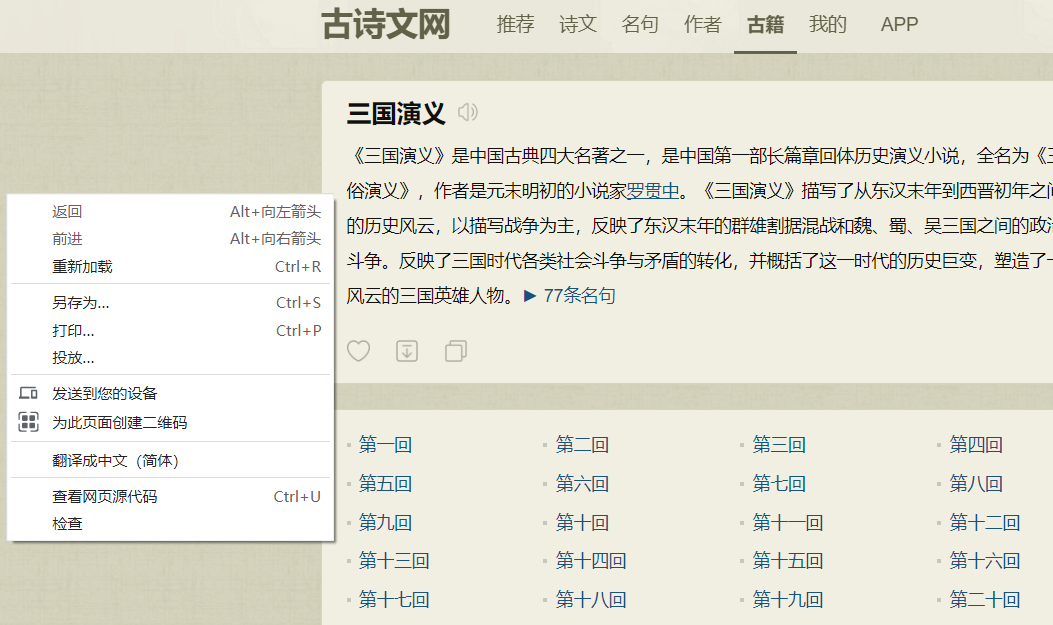
网页的源代码大致如下:
我们发现每一回的链接在网页中的标签 ul 里面,具体在其每个子标签 span 中的子标签 a 里面。
打开其中任一回的链接,在网页空白处单击右键,查看网页源代码:
我们发现每一回的内容在具体属性为 class=’contson’ 的 div 标签里,其中第一句为每一回的标题,而之后的内容为正文。
根据网页的以上两个特点,设计 Python 的爬虫代码如下。
import requests # 联系网络的包,a package for requesting from websites
from bs4 import BeautifulSoup # 分析网页数据的包,a package for webstie data analysis
import time
import random
import os
# 获取单个网页信息
def get_url_content(url):
# headers = {
# 'user-agent': 'Mozilla/5.0 (Windows NT 10.0; Win64; x64) AppleWebKit/537.36 (KHTML, like Gecko) Chrome/74.0.3729.108 Safari/537.36'
# } # 主要是模拟浏览器登录,防止反爬,一般的网站没有这个也行,谷歌浏览器 按 F12 能够找到网站支持的 headers
r = requests.get(url, timeout=30) # 获取网页的内容,并返回给r变量,timeout 为超时时间
# r.raise_for_status() # 检查返回网页的内容的状态码,200表示成功
# r.encoding = r.apparent_encoding # 统一编码方式
return r.text # 返回网页中的文本内容,数据内容为 r.content
# 解析出网页中想要的信息,爬虫的关键步骤
def filter_info(chapter_num, url_text):
soup = BeautifulSoup(url_text, "lxml") # 解析网页返回内容,lxml 是一个解码方式,效率比较快,被推荐使用
contents = soup.find("div", class_="contson")
# 使用 get_text 可以实现网页里面 p 标签中文本内容的换行,而 text 不能
chapter_title = contents.find("p").get_text() # 第一句话是本回的标题
chapter_title = "第" + str(chapter_num) + "回 " + chapter_title.lstrip()
# chapter_content = contents.get_text(separator="\n") # find 返回的不是列表,不用跟 [0]
chapter_content = contents.text
chapter_content = chapter_content.lstrip() # 去掉字符串左边的空字符
this_chapter = [chapter_title, chapter_content]
return this_chapter
# 从网页中找到每一回的链接
def get_url_links(url_head_content):
soup = BeautifulSoup(url_head_content, "lxml") # 解析网页返回内容,lxml 是一个解码方式,效率比较快,被推荐使用
# links = soup.find('div', class_='bookcont') # 每一回的链接都在类 span 里面
links = soup.find("ul") # 每一回的链接都在类 ul 里面
links = links.findAll("span")
link_list = []
for each in links:
link_list.append(each.a.get("href")) # 获取每一回的链接,存储到列表里
return link_list
# 将每章内容输出到 txt 文档里
def write_txt(string_array):
file_address = "E:/三国演义/" # txt 存放地址
if not os.path.exists(file_address): # 用os库判断对应文件夹是否存在
os.makedirs(file_address) # 如果没有对应文件夹则自动生成
file_name = string_array[0]
with open(
file_address + file_name + ".txt", "w", encoding="utf-8"
) as f: # 必须跟解码形式,不然有的网页中文内容写不到txt里
f.write(string_array[1])
# 主函数
def main():
url = "https://so.gushiwen.cn/gushi/tangshi.aspx" # 古诗文网三国演义网址
url_head_content = get_url_content(url) # 获取网页
links = get_url_links(url_head_content) # 获取每一回的链接地址
# enumerate() 函数用于将一个可遍历的数据对象(如列表、元组或字符串)组合为一个索引序列
# 同时列出数据下标和数据
for index, each in enumerate(links):
url_link_content = get_url_content(each) # 获取每一回的网页内容
chapter_content = filter_info(index + 1, url_link_content) # 解析每一回的网页内容,获取小说文本
write_txt(chapter_content) # 输出小说内容到 txt
time.sleep(random.random() * 1) # 每抓一个网页休息0~1秒,防止被反爬措施封锁 IP
# 运行函数
main()
其中,使用 requests 库时,有的网站需要设置 headers 参数才能正确模拟浏览器登录。headers 参数可以在打开网页时,按键盘F12 打开, 然后刷新一下网页,单击F12弹出窗口的任何一个文件,就能查看网站的所有 headers 信息,有 cookie,user-agent 等信息。如下图所示:

我们可以复制一部分信息或全部信息,放到 request 函数的 headers 参数里面。
9.5. 爬虫实例 2:抓豆瓣 top 250 的电影信息#
我们想获取豆瓣高分评价的 250 部电影的信息:电影名字,导演,上映年代,评分,评分人数等。打开豆瓣 top 250 的网页链接 https://movie.douban.com/top250?start= ,发现每个网页显示 25 部电影,一共有 10 个挖网页,网页地址与链接中的 start = 后面的数字有关。例如第 3 个子网页的链接地址是 ‘https://movie.douban.com/top250?start=50 ,根据这个规律,我们可以用一个 for 循环,将 10 个网页分别打开抓取信息。
打开一个网页,单击右键查看网页源代码,如下图所示:
通过源代码发现以下几个特点:
每部电影的信息都在标签 <div class=’item’> 里面。据此,我们可以用一个 for 循环,将每个网页的 <div class=’item’> 标签都检索出来
电影的中英文名字都在标签 <div class=’title’> 里,而其他名字在标签 <div class=’other’> 里。我们可以使用函数
find()以及find_next()检索出来。导演,主演,上映年代,电影产地,电影类型信息在标签 <p class=’’> 里。我们可以使用函数
find()检索,然后利用正则表达式将里面对应文本信息分别提取出来。评分信息在标签 <div class=’rating_num’> 里。我们可以使用函数
find()检索出来。评分人数信息在标签 <span> 里。我们可以通过函数
find()结合关键字’评价’检索出来。(网页中的 < span > 提供了一种将文本的一部分或者文档的一部分独立出来的方式)代表性评价信息在标签 <div class=’quote’> 里。我们可以使用函数
find()检索出来。
根据以上的特点,设计出以下的 python 代码。其中中文分词库jieba,词云库WordCloud库等,若没有安装,需要提前安装(使用 pip 或 conda 安装)到电脑上。
在画图时,使用 matplotlib 画出饼图,使用 WordCloud 生成词云图,因为 matplotlib 不能自动将不同柱子分配不同的颜色,使用 seaborn 画出柱状图。
import requests # 联系网络的包,a package for requesting from websites
import pandas as pd
from bs4 import BeautifulSoup # 分析网页数据的包,a package for webstie data analysis
import matplotlib.pyplot as plt # 画图的包
import time
import random
import jieba # 中文分词包
from wordcloud import WordCloud # 词云包
import re # 正则表达式包
import seaborn as sns # 用 seaborn 画柱状图
plt.rcParams["font.sans-serif"] = ["SimHei"]
# 主要是模拟浏览器登录,防止反爬
headers = {
"user-agent": "Mozilla/5.0 (Windows NT 10.0; Win64; x64) AppleWebKit/537.36 (KHTML, like Gecko) Chrome/74.0.3729.108 Safari/537.36"
}
# store the information
rank_list = []
name_list = [] # 用来存储电影名字的一个二维列表
director_list = [] # 用来存储导演名字的一个列表,下面几个变量类似
actor_list = []
year_list = []
rating_list = []
ratingNum_list = []
quote_list = []
place_list = []
category_list = []
num = 0
for i in range(0, 10):
link = "https://movie.douban.com/top250?start=" + str(
i * 25
) # 250部电影一共 10个网页, 10 pages for total 250 movies
res = requests.get(link, headers=headers, timeout=10)
time.sleep(
random.random() * 3
) # 每抓一个网页休息2~3秒,防止被反爬措施封锁 IP,avoid being blocked of the IP address
# res.text is the content of the crawler
soup = BeautifulSoup(
res.text, "lxml"
) # lxml 是一个解码方式,lxml is one decoding model for Beautifulsoup
movie_list = soup.find_all("div", class_="item") # 检索所有类型为 item 的 div 标签
for each in movie_list:
# 排名在 em 标签里
rank = each.em.text
rank_list.append(rank)
# 电影名字在标签 <span class="title"> 与 <span class="other"> 里
other_name = each.find("span", class_="other").get_text()
other_name = other_name.replace(" ", "") # 去掉空格
other_name = other_name.replace("\xa0/\xa0", "") # 去掉多余字符 \xa0/\xa0
cn_name = each.find("span", class_="title").get_text()
eg_name = (
each.find("span", class_="title").find_next().get_text()
) # find_next() 查找满足条件的下一个标签
eg_name = eg_name.replace("\xa0/\xa0", "") # 去掉多余字符 \xa0/\xa0
name_list.append([cn_name, eg_name, other_name])
# 评分信息在标签 <span class="rating_num"> 里
rating = each.find("span", class_="rating_num").get_text()
rating_list.append(float(rating))
# 评价人数通过关键词'评价'检索
rating_num = each.find(string=re.compile("评价")).get_text()
rating_num = rating_num.replace("人评价", "")
ratingNum_list.append(int(rating_num))
# 代表性评价在 <p class="quote"> 里
try:
quote = each.find("p", class_="quote").get_text()
except Exception: # 有的电影代表性评价没有显示
quote = ""
quote_list.append(quote)
info = each.p.get_text(strip=True)
# 定义正则表达式提取出导演,主演,上映时间,地点,电影类型信息
try:
# (?<=导演: ) match any character begins after character '导演: '
# .*? match any character (.), zero or more times (*) but as less as possible (?)
# (?=主) match any character before character '主'
director = re.compile("(?<=导演: ).*?(?=主)").findall(info)[0]
actor = re.compile("(?<=主演: ).*?(?=/)").findall(info)[0]
except Exception: # 有的电影导演名字太长,主演没有显示出来
director = re.compile("(?<=导演: ).*?(?=\xa0)").findall(info)[0]
actor = ""
director_list.append(director)
actor_list.append(actor)
# \d{4} is a four digit number
year = re.compile("(?<=...)\d{4}").findall(info)[0]
year_list.append(year)
place_category = re.compile("(?<=\xa0/\xa0).*").findall(info)[0]
place_category = place_category.replace("\xa0", "")
place_category = place_category.split("/")
place = place_category[0]
category = place_category[1]
place_list.append(place)
category_list.append(category)
# 将数据存到 pandas 里
df = pd.DataFrame(rank_list, columns=["排名"])
df["电影名字"] = [i[0] for i in name_list]
df["外文名字"] = [i[1] for i in name_list]
df["其他名字"] = [i[2] for i in name_list]
df["评分"] = rating_list
df["评价人数"] = ratingNum_list
df["导演"] = director_list
df["主演"] = actor_list
df["上映日期"] = year_list
df["地区"] = place_list
df["类型"] = category_list
df["代表性评论"] = quote_list
# 导出到 xls 文件里,save to xls file
df.to_csv("豆瓣 top 250 电影爬虫抓取.csv")
# 分析电影来源地并画饼图
locations = []
for i in range(len(place_list)):
nations = place_list[i].split(" ")
for j in range(len(nations)):
if nations[j] == "西德":
nations[j] = "德国"
locations.append(nations[j])
df_location = pd.DataFrame(locations, columns=["地区"])
# 按照出现次数排序, size() 可以查数,生成一个 Series 类型
# 然后用 reset_index 重新命名,参数为 name
# DataFrame 类型的 reset_index 参数为 names
df2 = (
df_location.groupby("地区").size().reset_index(name="counts")
) # df2 = df2['地区'].value_counts(ascending = False).reset_index()
df2.sort_values(by="counts", ascending=False, inplace=True, ignore_index=True)
# 画饼状图
values = []
labels = []
other_count = 0
for i in range(9):
values.append(df2["counts"][i])
labels.append(df2["地区"][i])
for i in range(9, df2.shape[0]):
other_count += int(df2["counts"][i])
values.append(other_count)
labels.append("其他地区")
plt.figure(1)
plt.pie(values, labels=labels, autopct="%.2f%%")
plt.legend() # 显示标签
plt.show()
# 分析电影类型并画饼图
categories = []
for i in range(len(category_list)):
category = category_list[i].split(" ")
for j in range(len(category)):
categories.append(category[j])
df_category = pd.DataFrame(categories, columns=["类型"])
df3 = df_category.groupby("类型").size().reset_index(name="counts")
df3.sort_values(by="counts", ascending=False, inplace=True, ignore_index=True)
values = []
labels = []
other_count = 0
for i in range(15):
values.append(df3["counts"][i])
labels.append(df3["类型"][i])
for i in range(15, df3.shape[0]):
other_count += int(df3["counts"][i])
values.append(other_count)
labels.append("其他类型")
plt.figure(2)
plt.pie(values, labels=labels, autopct="%.2f%%")
plt.legend()
plt.show()
# 画词云图
jieba.add_word("久石让")
jieba.add_word("谢耳朵")
# 一些语气词和没有意义的词
del_words = ["就是", "一个","被","电影","我们","不是","每个","不会",
"没有","这样","那么","不要","如果","不能",
"一种","不过","只有","不得不","不得不","一部",
]
all_quotes = "".join(quote_list) # 将所有代表性评论拼接为一个文本
# 去掉标点符号
all_quotes = re.sub(
r"[0-9\s+\.\!\/_,$%^*()?;;:-【】+\"\']+|[+——!,;:。?、~@#¥%……&*()]+", " ", all_quotes
)
words = jieba.lcut(all_quotes)
words_final = []
for i in range(len(words)):
if len(words[i]) > 1 and words[i] not in del_words: # 去掉一些语气词,单字词
words_final.append(words[i])
text_result = Counter(words_final)
cloud = WordCloud(
font_path="C:\Windows\Fonts\FZSTK.TTF", # 中文字体地址 C:\Windows\Fonts\FZSTK.TTF,提前下载字体或指定,否则中文无法显示
# mask = '' 通过 mask 参数指定一个图片地址作为词云的背景图像
background_color="white",
width=1000,
height=860,
max_words=25,
)
# wc = cloud.generate(words) # 这种方法对中文支持不太好,this mehtod is better for only english string
wc = cloud.generate_from_frequencies(text_result)
wc.to_file("豆瓣 TOP 250 词云.jpg")
plt.figure(3)
plt.imshow(wc)
plt.axis("off")
plt.title("豆瓣 TOP 250 电影代表性评论的词云分析")
plt.show()
# 评分最高的 15 部电影
# 用 seaborn 画柱状图,因为自动将不同柱子分配不同的颜色
df_star = df.sort_values(by="评分", ascending=False, ignore_index=True)
number = 15
df_star_top = df_star.head(number)
plt.figure(4)
sns.barplot(data=df_star_top, y="电影名字", x="评分", orient="h")
plt.title("评分最高的 " + str(number) + " 部电影")
plt.show()
# 评分人数最多的 15 部电影
df_num = df.sort_values(by="评价人数", ascending=False, ignore_index=True)
df_num_top = df_num.head(number)
plt.figure(5)
sns.barplot(data=df_num_top, y="电影名字", x="评价人数", orient="h")
plt.title("评分人数最多的 " + str(number) + " 部电影")
plt.show()
# 电影年代画图
df_year = df.groupby("上映日期").size().reset_index(name="部数")
df_year.sort_values("部数", ascending=False, inplace=True)
df_year_top = df_year.head(20)
df_year_top.sort_values("上映日期", inplace=True)
plt.figure(6)
sns.barplot(data=df_year_top, x="上映日期", y="部数")
plt.title("电影上映年代")
plt.show()
生成的图形如下:
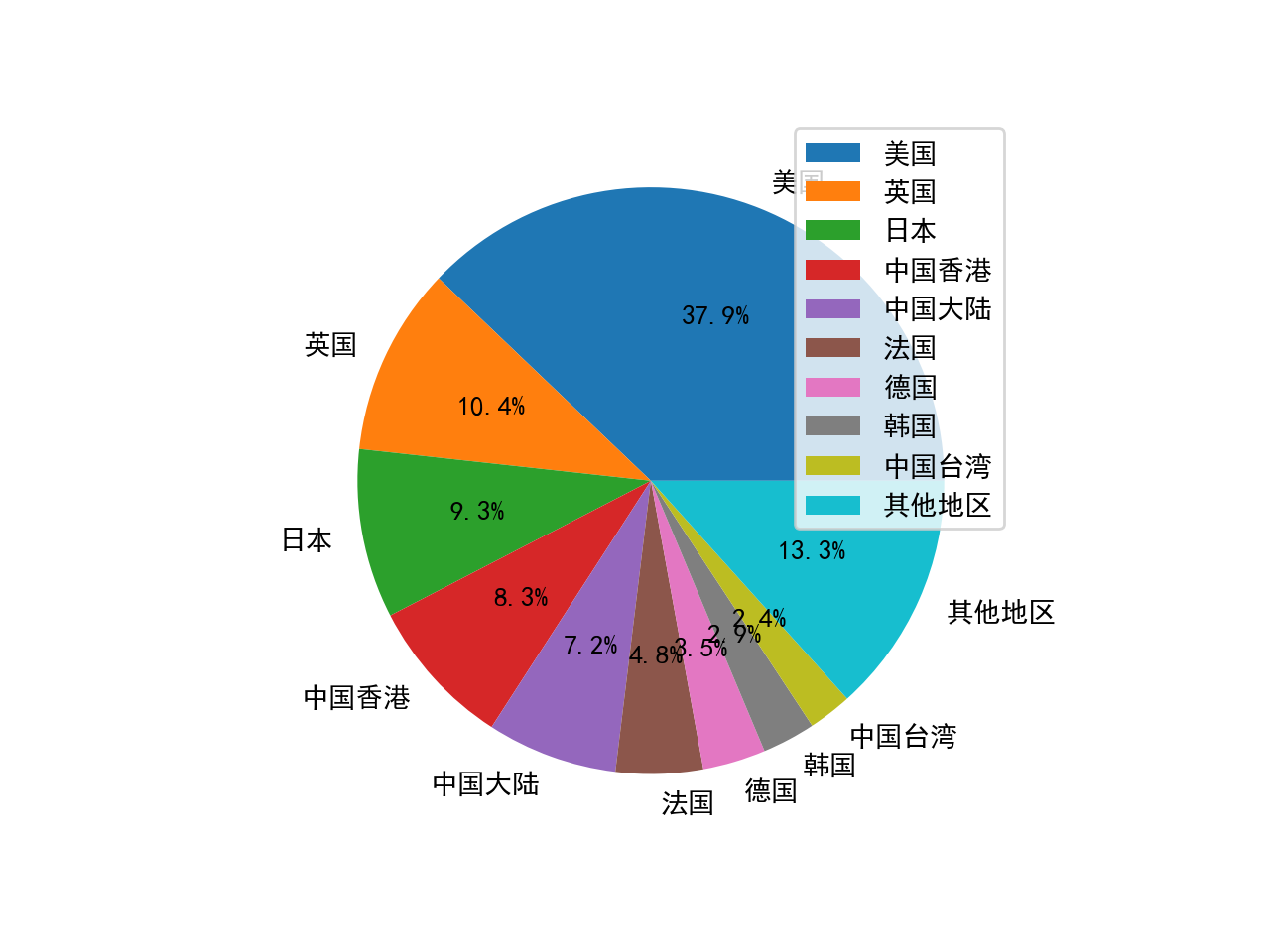

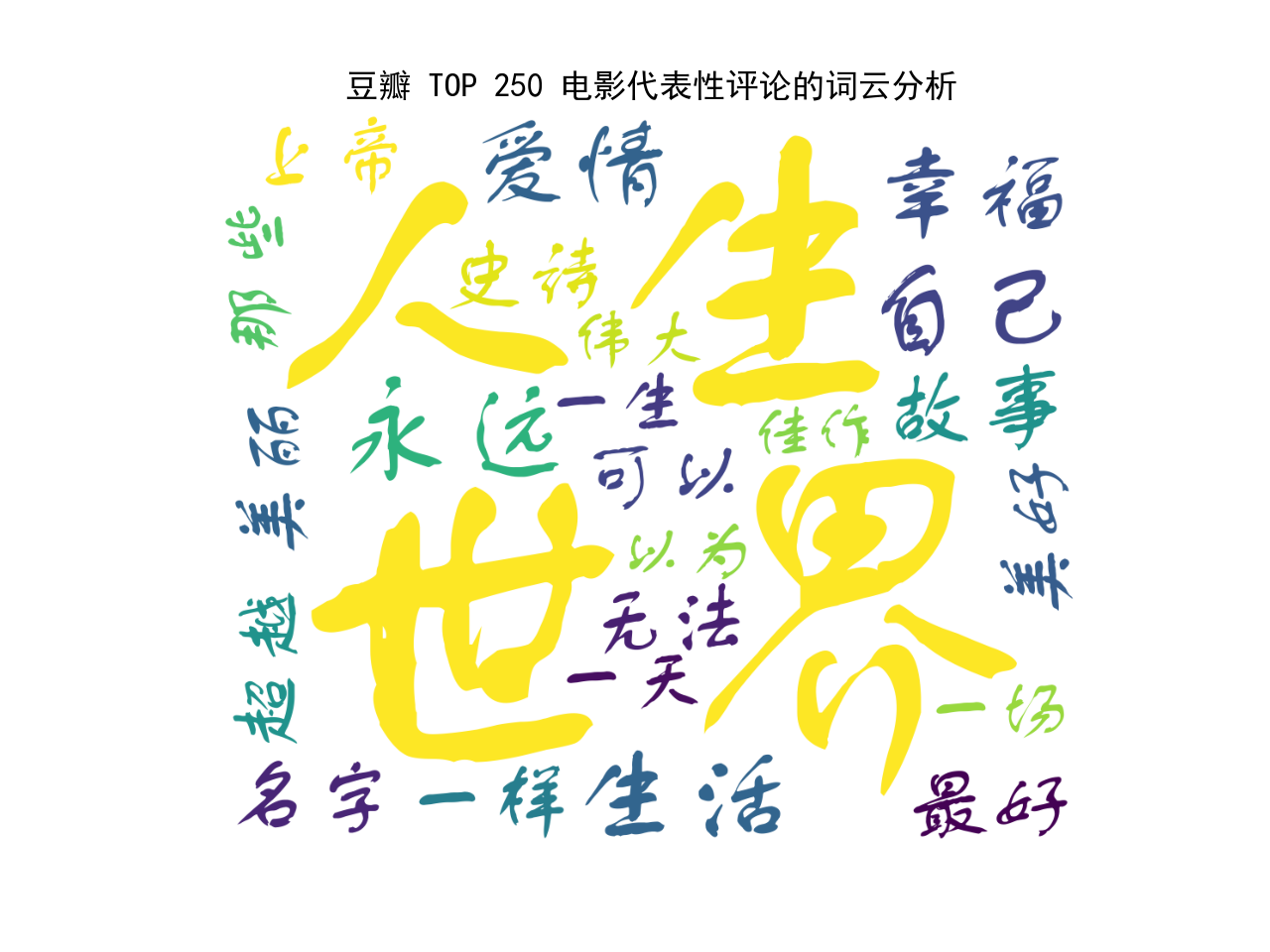
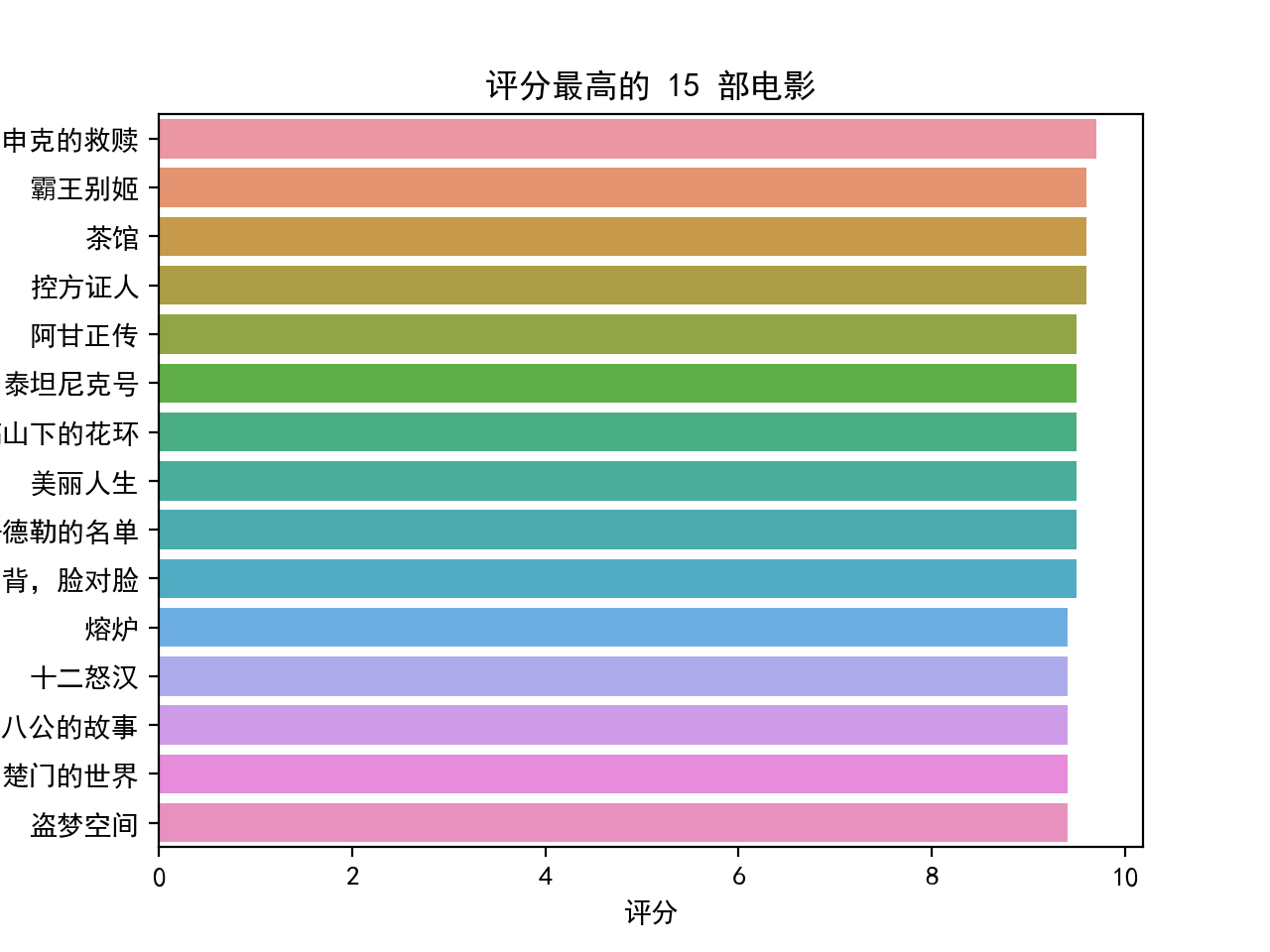
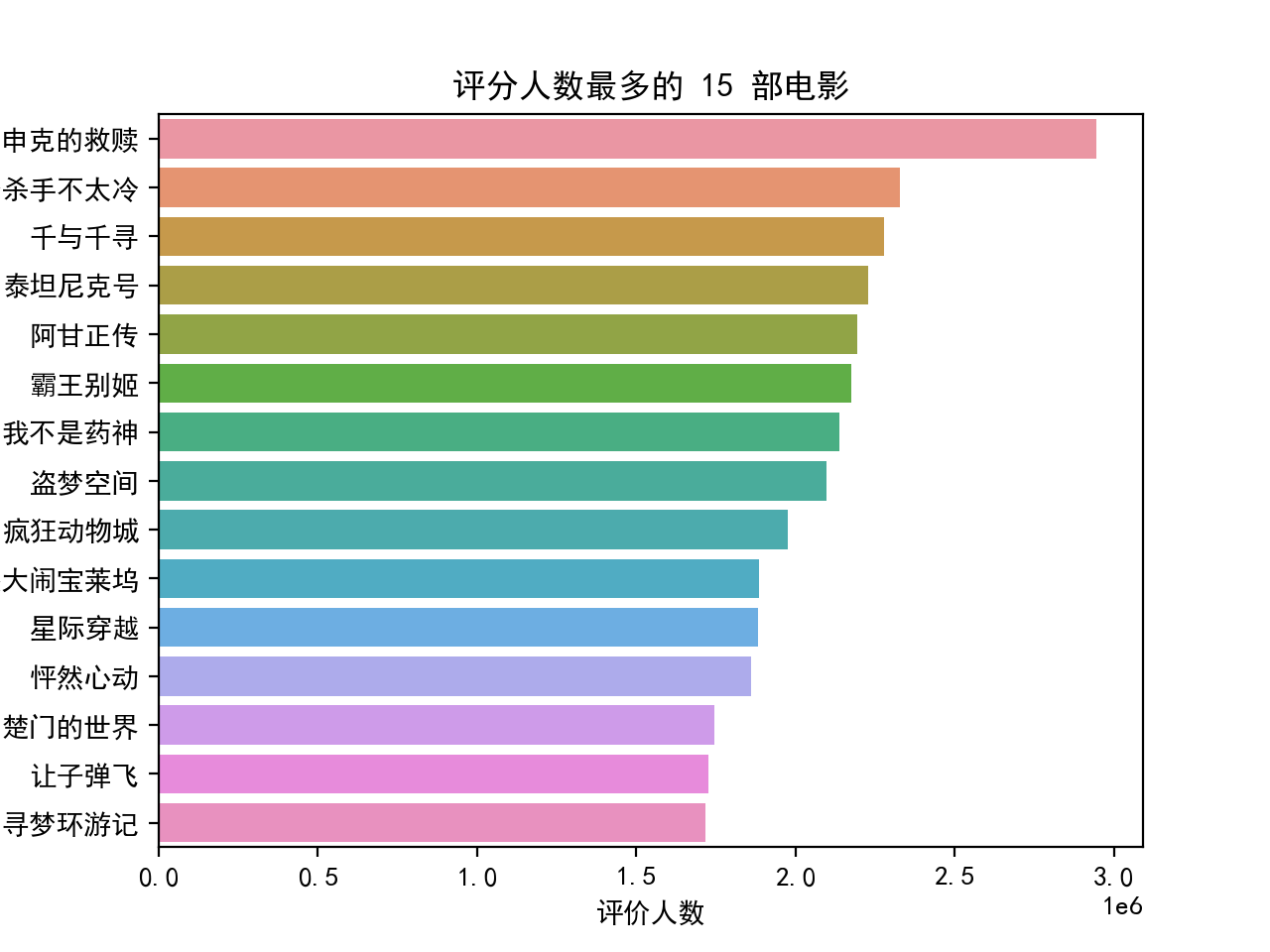

9.6. 后记#
不同的网站的爬虫技巧经常不一样,要具体网站具体分析。
由于一些网站经常更新数据的存储地址或源代码,某段时间的爬虫代码可能在下一个时间段就不能用了,爬虫代码也要更新。
有的网页信息并不在网站直接打开的网页源代码里(例如弹幕、电商评论等),还要结合按键
F12找到网页信息的真实地址。提取网页信息时,经常要用到正则表达式处理字符串。
近年来,许多网站都提高了反爬手段防止网站的数据被无端获取。因此,提醒读者避免过度使用爬虫,给一些网站造成不必要的访问负担。
9.7. 练习#
Exercise 9.1
练习从网上抓取一首诗词。
Exercise 9.2
练习抓取学校的新闻,并尝试画出词云图。
Exercise 9.3
尝试用爬虫下载小说《红楼梦》到电脑里。

